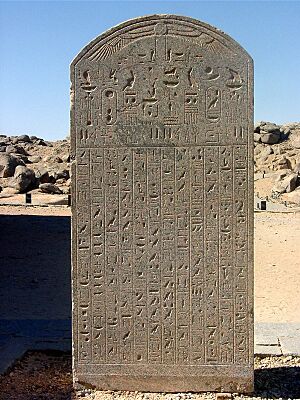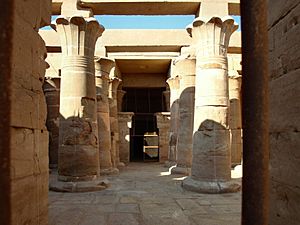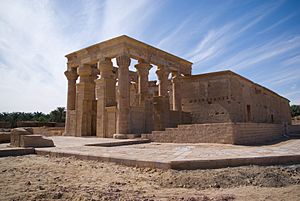Psamtik II facts for kids
Quick facts for kids Psamtik II |
|
|---|---|
| Psammetichus II | |
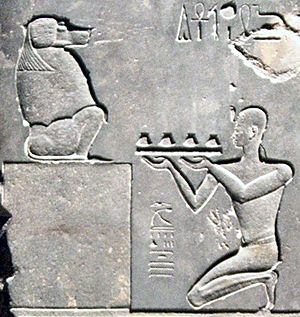
Psammetichus II making an offering
|
|
| Pharaoh | |
| Reign | 595–589 BC (26th dynasty) |
| Predecessor | Necho II |
| Successor | Apries |
| Consort | Takhuit |
| Children | Apries, Ankhnesneferibre |
| Father | Necho II |
| Mother | Khedebneithirbinet I |
| Died | 589 BC |
Psamtik II (also spelled Psammetichus) was an important king of ancient Egypt. He ruled from 595 BC to 589 BC. He belonged to the Twenty-sixth Dynasty of Egypt. His special king name, Nefer-Ib-Re, meant "Beautiful is the Heart of Re." Re was a powerful sun god. Psamtik II was the son of another pharaoh, Necho II.
Contents
Psamtik II's Military Actions
Campaign Against Nubia
In 592 BC, Psamtik II led his army on a big trip into Nubia. This land was south of Egypt. His army marched far south along the Nile River. They went past the Third and even the Fourth waterfalls (called cataracts) on the Nile.
A stone tablet from the city of Thebes tells us about this trip. It says that Psamtik II's army won a big victory. They defeated the kingdom of Kush, which was in Nubia.
A famous message was carved in Greek on a giant statue of Ramesses II. This statue is at the entrance to the Abu Simbel temples. The message says that soldiers from different lands, like Greeks and Carians, traveled with Psamtik II. They went very far south, led by their commanders.
This was the first time Egypt fought Nubia in a long time. The Nubian kings of Kush had become powerful again. Psamtik II's goal was to stop them from trying to take over Egypt. The Egyptian army attacked cities like Pnubs (Kerma) and Napata, the capital of Kush. They fought many fierce battles. They even took treasures from temples and broke royal statues in Kush.
A stone tablet from Karnak, dated to Psamtik II's third year as king, describes the battle:
The army that your Majesty sent to Nubia has reached the land of Pnubs....Nubians from all parts [of Kush] had arisen against him...His Majesty took part in the combat as soon as he reached the battle. The rebels gave up before a single arrow was shot...Those who tried to run away did not succeed and were brought back as prisoners: four thousand two hundred men.
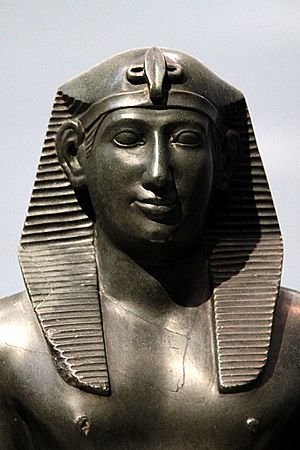
Because of Psamtik II's strong attack, the power of Kush was greatly weakened. Their kings could no longer hope to rule Egypt. Instead, the Nubian rulers moved their capital city further south. They moved it from Napata to a safer place called Meroë.
Even though Psamtik II won a big victory, his army did not stay in Nubia. They went back to the First Cataract of the Nile. The city of Elephantine remained the southern border of Egypt.
After this campaign, Psamtik II also ordered the destruction of monuments. He had the names and royal symbols of earlier Nubian kings removed from their statues and carvings in Egypt. This was to show that their rule was over.
Trip to Palestine
In 591 BC, Psamtik II also sent an army to Palestine. This was to encourage people there to rebel against the Babylonians. One of the leaders involved was Zedekiah, the king of Judah.
Building Projects of Psamtik II
Psamtik II was a strong warrior king. But he was also a busy builder during his short six-year rule.
Major Temples and Obelisks
He and his son Apries likely built a large temple in a village called El-Mahalla El-Kubra. This village is in the Lower Nile Delta. People who visited Egypt long ago saw many ancient Egyptian building parts there. These parts were made of granite and turquoise. They had been reused in newer buildings, like a mosque.
During Psamtik II's reign, two very tall stone pillars, called obelisks, were put up. They were over 21 meters high. They stood in the temple of Heliopolis. Later, the Roman Emperor Augustus moved one of these obelisks to Rome. Today, it is known as the Obelisk of Montecitorio.
Psamtik II also built a small structure on Philae island. This building is the oldest known monument on the island. It had two rows of four columns. These columns were connected by walls.
The Temple of Hibis
Psamtik II also started building the Temple of Hibis in the Kharga Oasis. This temple was for the gods Amun, Mut, and Khonsu. It also had important areas for the worship of Osiris.
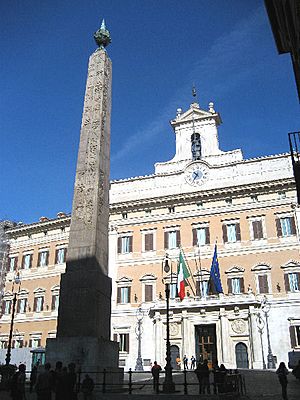
This temple was about 19.5 by 26 meters in size. It was originally next to an ancient lake that is now gone. The temple's decorations were finished much later by Persian kings.
The Hibis temple had a large hall with many columns. It also had a hall for offerings and three special rooms for gods. There was also a small chapel for Psamtik II's own worship. The front of the temple had a porch with four columns.
A huge sandstone gateway still stands almost 5 meters tall at the temple. It was built later, during the Ptolemaic or Roman times. Many messages and rules were carved on this gateway. They talked about things like taxes, family inheritance, and the rights of women.
The Temple of Psamtik II at Hibis was very well preserved until 1832. Then, its roof and parts of the temple were removed to build a factory. Only later work by the Metropolitan Museum of Art and Egyptian experts stopped its destruction. Today, the Hibis temple is one of the best-preserved ancient Egyptian temples from its time.
Psamtik II's Family and Successor
Psamtik II died in 589 BC. His son, Apries, became the next king. Apries' mother was Queen Takhuit.
Psamtik II and Queen Takhuit also had two daughters. One was Menekhubaste, who was a priestess. The other was Ankhnesneferibre. She held a very powerful religious position called "God's Wife of Amun" in Upper Egypt. She held this position until Egypt was taken over by the Persians in 525 BC.
Images for kids
-
Statue of Psamtik II. Louvre Museum
See also
 In Spanish: Psamético II para niños
In Spanish: Psamético II para niños


